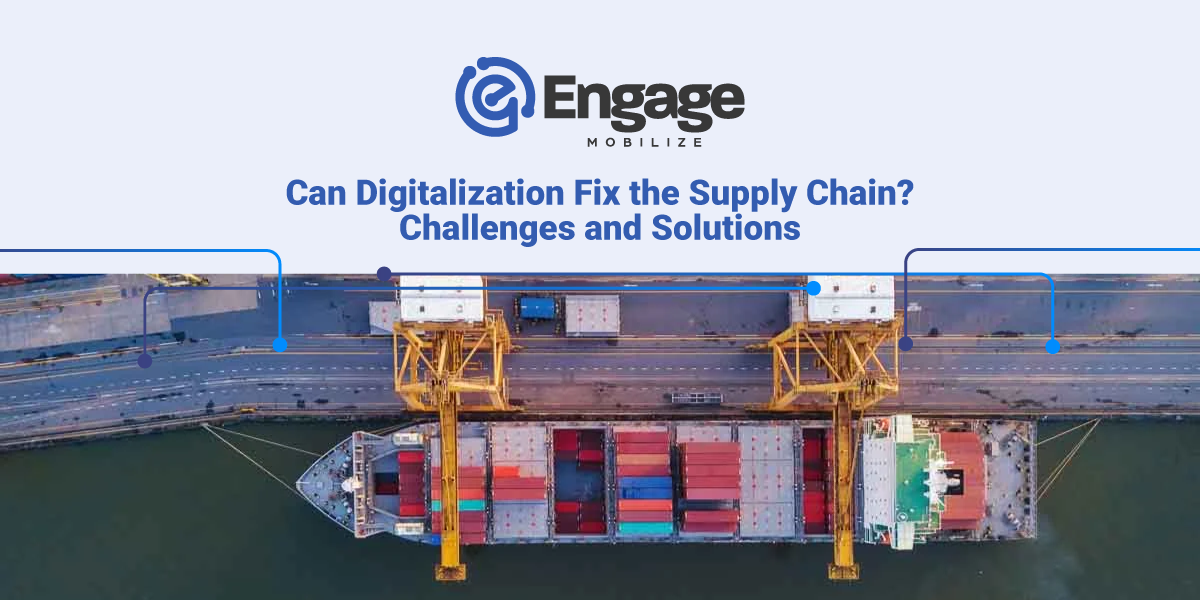
“The digital supply chain has the potential to completely change supply chain. However, do your due diligence before rushing in.” ~ Everything Supply Chain
Anyone who has had to track a shipment or shut down production due to shortages of raw materials knows the pain of supply chain disruption. It’s always been an issue in industrial operations.
However, recent events ranging from lockdowns to embargoes and evolving regulations on import/exports have exacerbated the problem.
As stakeholders from operators in the field to retail distributors search for options and alternatives, many overlook solutions that are already at hand.
If your company isn’t among the 70% that are onboard with supply chain digitalization, you’re missing the opportunity to improve production and service deliverability.
What is Supply Chain Digitalization?
Supply chain digitalization, sometimes called Logistics 4.0, is a facet of a broader digital transformation known as Industry 4.0. It works by transforming your core business platforms from manual, paper-based processes to automated systems that are faster, intuitive, more accurate, and auditable.
When fully integrated with other platforms, like inventory management systems, CRMs, and ERPs, you’ll have an end-to-end business management solution that does more than just keep your accounts up to date.
To understand how supply chain can be streamlined, it helps to review how the supply chain works in industrial enterprises and then delve into specific ways that automation addresses the complexities of logistics.
The Energy Sector Supply Chain in Action
Beginning with acquisition of raw materials for production, the energy sector supply chain extends through upstream, midstream, and downstream activities:
- Exploration and field development
- Extraction and refining
- Transportation and storage
- Power generation and retail distribution
The supply chain includes the entire process of moving materials in various states of readiness that can extend over thousands of miles of ocean and terrain or just across town.
Businesses need to move materials to manufacturing plants or the field, transport them within facilities, process or refine, store them, and then transport them to their final destination. From there, individual companies need deliveries so that they can serve their customers. Waste management is also folded into the mix, in addition to mitigating the environmental impact and managing financial transactions along the way.
Company leaders need timely intelligence for planning, budgeting, and day-to-day decision-making. They also have to make sure that they remain compliant with changing regulatory mandates and shifting trends within the industry.
Even the smallest local operator would have trouble managing the various components manually or using outdated technology.
How Digitalization Resolves Supply Chain Problems
Whether your company is in oil & gas, renewable energy, or some other segment of energy production and sales, the goals are the same. You want to improve efficiency, streamline processes and keep the product flowing while keeping costs down and bottom lines healthy. In between, there are pressures from environmental agencies and the realities of doing business in a post-pandemic world.
The issues can seem insurmountable without the aid of technology.
One of the barriers to digital transformation in energy sector companies is finding solutions that address the unique problems and processes inherent in the energy sector. Although many have adopted emerging technologies to optimize production within their facilities, the benefits of technology in the supply chain to address predictability and reduce operating cost from origin to market are only just being realized.
Many companies had to take a hard pivot toward improving supply chain efficiency due to external circumstances beyond anyone’s control, and they had to do it on the fly.
The main issues still facing energy sector stakeholders are:
- Difficulties in demand forecasting. Digitalization addresses this problem by capturing and analyzing accurate data sets in order to provide more reliable information to predict demand. Because the technology is rooted in AI and Big Data analytics, the information is constantly refined and updated.
- Port congestion. Digitalization has been used to address this problem at ports across the globe through innovations like just-in-time shipping, smart bills of lading, and hands-free mooring using smart technology.
- Route disruptions. Running into unexpected construction or accidents that block routes is not only frustrating, it also leads to delivery delays, higher fuel consumption, and other issues. Predictive technology and GPS systems are used to find more efficient transportation routes or reroute trucks mid-delivery to avoid costly delays. More time and money efficient deliveries improve customer relations and reduce overall shipping costs.
- Increased cost of shipping. The cost of shipping is one of the most frustrating aspects of supply chain disruption. Demand has driven up prices. Taxes, regulatory requirements, and labor shortages add to the problem and further cut into profits.
Data gathered at all points during the production and delivery process can be used to detect inefficiencies and support data-driven decisions to close the revenue gap and streamline operations. Inventory management systems can anticipate demand at scale and avoid the problems of insufficient shipping capacity, empty containers, and shortages of raw materials needed for production.
- Lack of stakeholder buy-in. One of the biggest hurdles to industry-wide acceptance of digital transformation is the mindset of stakeholders at all levels of the operation. Although much of this mindset has changed by the realities of being forced into reliance on technology during the height of the pandemic, this still remains a problem.
This can be resolved through an investment in staff training and education, upgrading your leadership team, and tying investment in new technologies to improved outcomes. By improving communications at all levels and taking an incremental approach to digital transformation, demonstrable results can change mindsets.
- Reliance on third parties. Few enterprises rule the entirety of the supply chain from origin to market. Most must negotiate an increasingly complex network of connections from a range of industries, including shipping companies, warehousing, airlines, and government agencies.
Integrated, end-to-end digital platforms resolve these issues through data and format standardization, reducing touch points, and enabling more granular control over the entire process. Improved data collection and analysis support more comprehensive evaluation. It also provides the ability to link cross-functional information related to inventory management, warehouse management, and shipment scheduling.
When everyone is on the same page, with access to timely, accurate information that’s in one standard format across all platforms, coordinating with multiple parties and systems becomes more efficient and seamless.
The Future of Digitalization in the Energy Sector
According to industry analysis, the market for AI-powered advanced technologies will double to $4.2 billion by 2024.
In order for your digital transformation to alleviate supply chain problems, it’s important to evaluate your current operation, determine where digitalization will improve operations, and plan ahead.
It helps to weigh the benefits in relation to cost and return on investment at all levels of the organization and all points along the way from start to finish.
As the result of further investment in digital technologies, it’s expected that:
- Upstream oil and gas production will realize savings from $2 – $12 per barrel
- Recoverable oil and gas resources could experience a 5% boost globally
- Midstream deals could increase to more than $50 billion in oil sub-sectors
- Carbon emissions could be reduced by 20 percent
Rather than waiting for the government to finalize plans to address problems with supply chain efficiency and security, industrial enterprises can take a proactive approach to digital transformation.
Final Thoughts
When you’re looking for cutting-edge solutions to streamline your business, finding the right partner is a critical step. Engage Mobilize provides intelligent field operations software to digitalize your ticketing and invoicing workflow end-to-end. Our E-Ticketing and E-Invoicing solution is built specifically for Oil & Gas, proven for over 250 service types, and generates real-time business intelligence at scale.
We’re driven by a passion for innovation, integrity, and sustainability. Get in touch with us through our website to book a consultation today. You can also call (720) 575-6695 or shoot us an email at Sales@engage-m.com.
Are you ready to learn more?
We’re ready to talk to you about the specific cost savings, workflow efficiencies and data insights that come from taking your field operations digital.
Share this
Similar Stories

Digital Tech Trends in Oil & Gas: Engage Mobilize at EnerCom Denver, 2022

Field Service Automation Frees Up Brainpower
